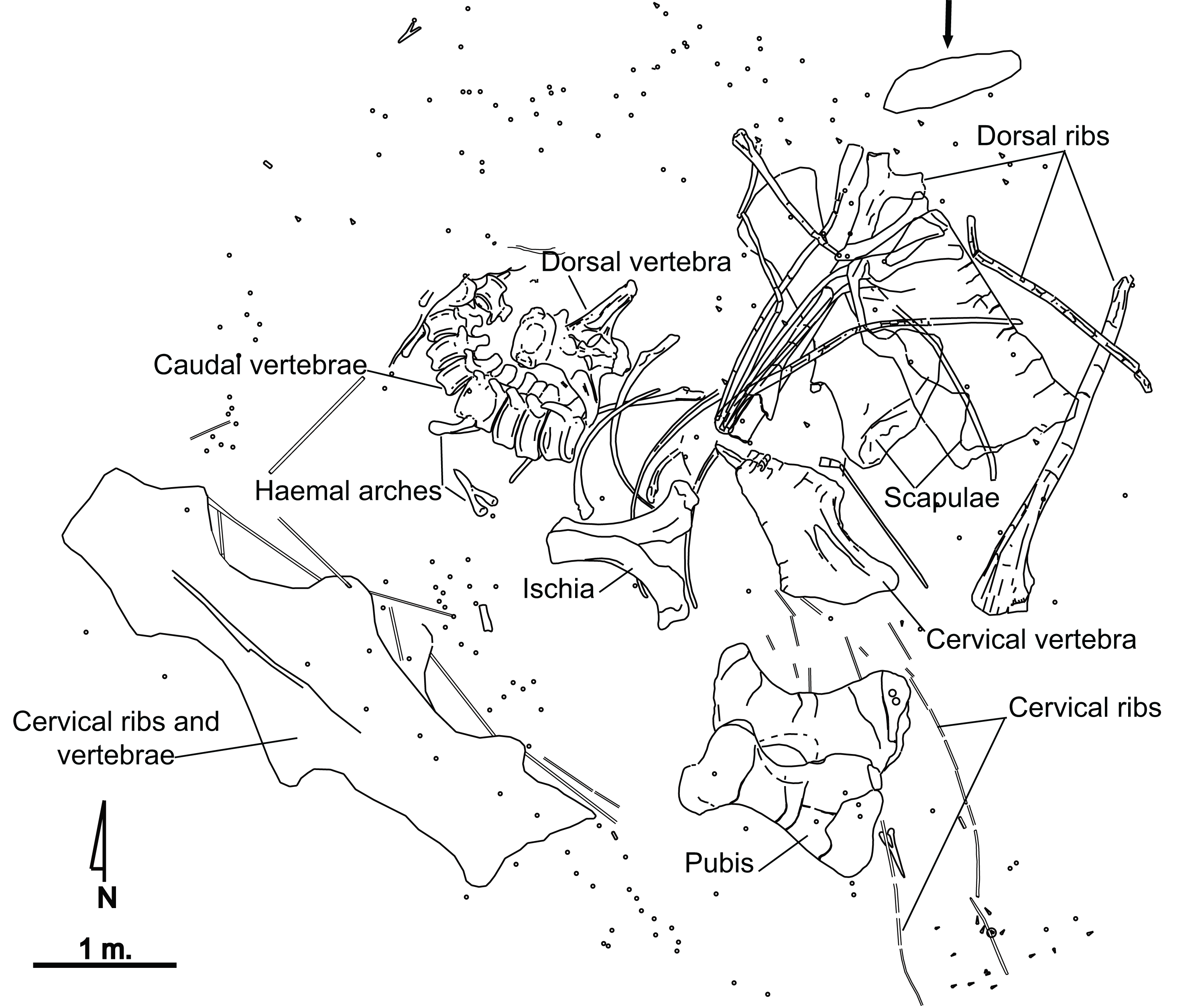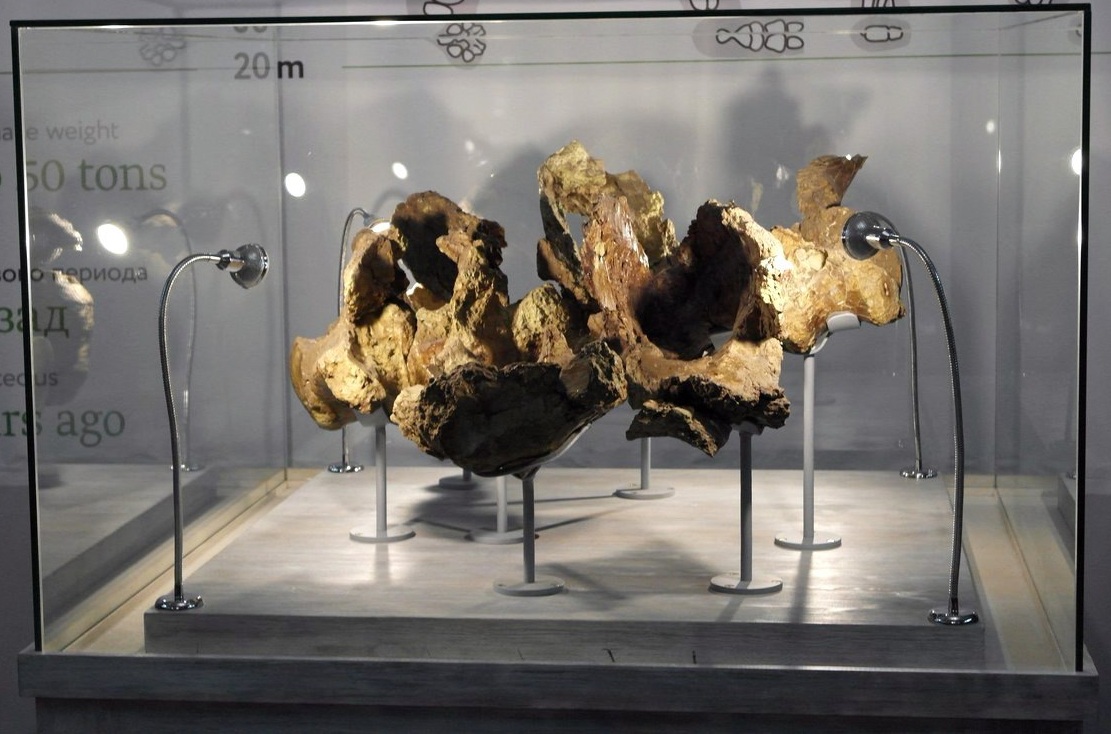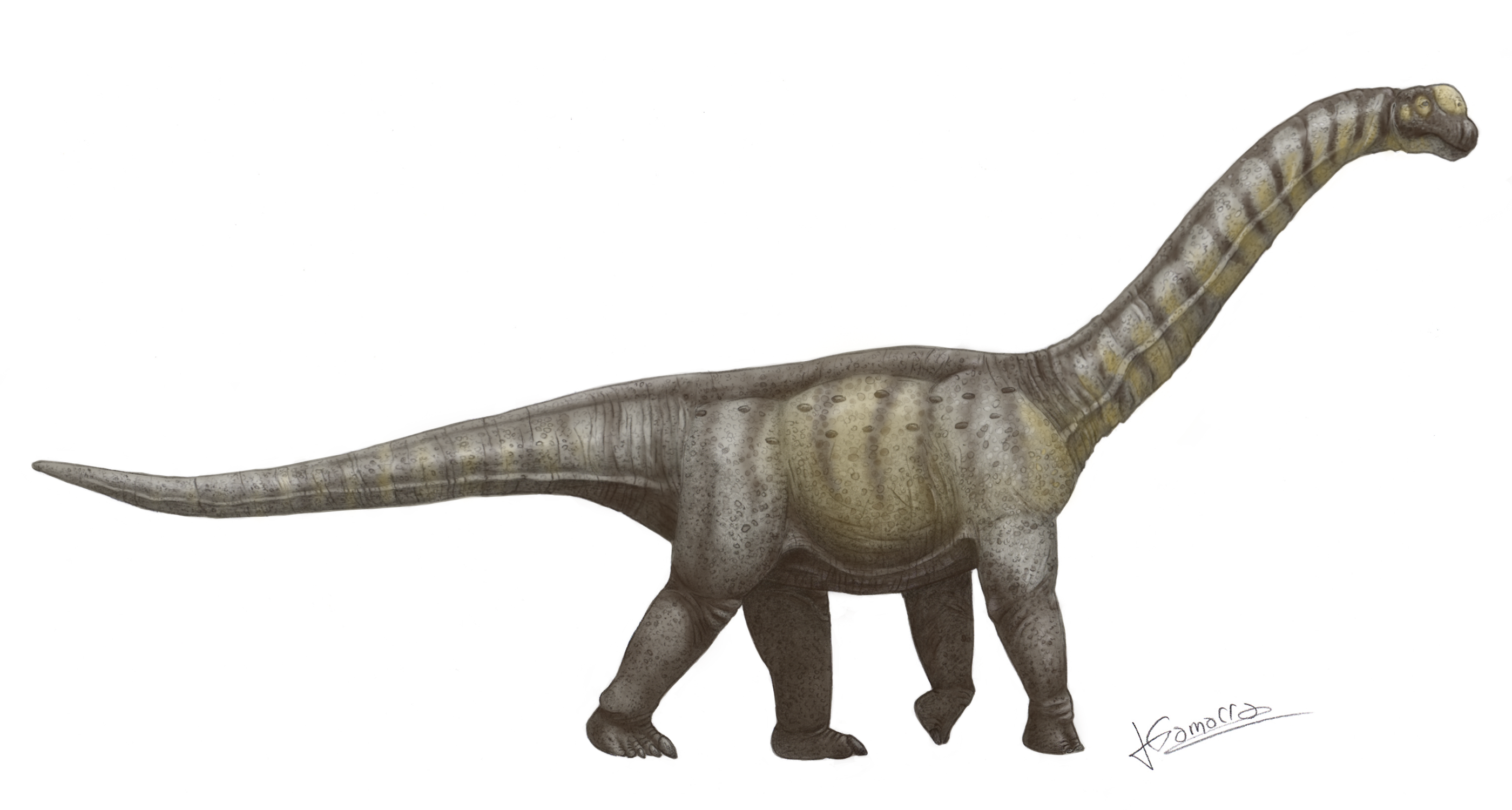|
Somphospondyli
Somphospondyli is an extinct clade of titanosauriformes, titanosauriform sauropods that lived from the Late Jurassic until the end of the Late Cretaceous, comprising all titanosauriforms more closely related to Titanosauria proper than Brachiosauridae. The remains of somphospondylans have been discovered on all continents. Classification The group has officially been defined under the PhyloCode as the largest clade containing ''Saltasaurus loricatus'', but not ''Giraffatitan brancai.'' Features found as diagnostic of this clade by Mannion ''et al.'' (2013) include the possession of at least 15 cervical vertebrae; a wikt:bevel, bevelled radius bone end; sacral vertebrae with camellate internal texture; wikt:convex, convex posterior articular surfaces of middle to posterior caudal vertebrae; wikt:biconvex, biconvex distal caudal vertebrae; humerus anterolateral corner "squared"; among multiple others. The following cladogram depicts the reference phylogeny used to defined Somphospo ... [...More Info...] [...Related Items...] OR: [Wikipedia] [Google] [Baidu] |
Europatitan
''Europatitan'' is an extinct genus of Somphospondyli, somphospondylan sauropod from the Early Cretaceous Castrillo de la Reina Formation of Iberia, known from a relatively complete specimen discovered in the early 2000s. It contains a single species: the type species, ''Europatitan eastwoodi''. Discovery and naming Sauropod remains were first found at a locality called El Oterillo II, which is part of the Castrillo de la Reina Formation in the province of Burgos in Spain in 2003. These remains would be excavated between 2004-2006. The fossils, although not initially described, we reported as those of a Macronaria, titanosauriform in 2009. They were given the designations MDS-OTII.1 to NDS-OTII.32 and have been stored at the Dinosaur Museum of Salas de los Infantes. Finally, in 2017, the specimen received a full description by the authors Fidel Torcida Fernández-Baldor, José Ignacio Canudo, Pedro Huerta, Miguel Moreno-Azanza, and Diego Montero. All of the sauropod bones di ... [...More Info...] [...Related Items...] OR: [Wikipedia] [Google] [Baidu] |
Titanosauria
Titanosaurs (or titanosaurians; members of the group Titanosauria) were a diverse group of Sauropoda, sauropod dinosaurs, including genera from all seven continents. The titanosaurs were the last surviving group of long-necked sauropods, with taxa still thriving at the time of the Cretaceous–Paleogene extinction event, extinction event at the end of the Cretaceous. This group includes some of the Largest land animal, largest land animals known to have ever existed, such as ''Patagotitan'', estimated at long with a mass of , and the comparably-sized ''Argentinosaurus'' and ''Puertasaurus'' from the Patagonia, same region. The group's name alludes to the mythological Titan (mythology), Titans of ancient Greek mythology, via the type genus (now considered a ''nomen dubium)'' ''Titanosaurus''. Together with the Brachiosauridae, brachiosaurids and relatives, titanosaurs make up the larger sauropod clade Titanosauriformes. Titanosaurs have long been a poorly-known group, and the rela ... [...More Info...] [...Related Items...] OR: [Wikipedia] [Google] [Baidu] |
Ligabuesaurus
''Ligabuesaurus'' is a genus of titanosauriformes, somphospondylan sauropod from the Early Cretaceous Lohan Cura Formation of what is now Argentina. The type species, ''Ligabuesaurus leanzai'', was described in 2006, based on a partial skeleton with a skull. The generic name, ''Ligabuesaurus'', honors Giancarlo Ligabue, while the specific name (zoology), specific name, ''leanzai'', honors the geologist Dr. Héctor A. Leanza, who discovered the skeleton in the Lohan Cura Formation. Discovery and naming The prominent Argentine paleontologist José F. Bonaparte led expeditions throughout northwestern Patagonia during the late 1990s and early 2000s. One of these expeditions, in 1997, examined a site called Cerro de los Leones, which is to the West of Picún Leufú. This locality is part of the Cullín Grande Member of the Lohan Cura formation. This expedition led to the excavation of the enigmatic and controversial sauropod genus ''Agustinia''. Additional remains of sauropods were ... [...More Info...] [...Related Items...] OR: [Wikipedia] [Google] [Baidu] |
Dongbeititan
''Dongbeititan'' is a genus of sauropod dinosaur from the Early Cretaceous-age Yixian Formation of Beipiao, Liaoning, China. It is based on holotype DNHM D2867, a partial postcranial skeleton including bones from the limbs, shoulder and pelvic girdles, and vertebrae, which was described in 2007. Its describers suggested it was as a basal titanosauriform, not as derived as '' Gobititan'' or ''Jiutaisaurus'', but more derived than ''Euhelopus'', ''Fusuisaurus'', and ''Huanghetitan''. The type species is ''D. dongi'', and it is the first named sauropod from the Yixian Formation, which is part of the well-known Jehol Group. The genus name refers to the region Dongbei and to Greek titan, "giant". The specific name honours the Chinese paleontologist Dong Zhiming. Like other sauropods, ''Dongbeititan'' would have been a large quadrupedal herbivore. Discovery Fossils of an unknown dinosaur were found in north-eastern China, in western Liaoning province, in the region of Beipiao. The ... [...More Info...] [...Related Items...] OR: [Wikipedia] [Google] [Baidu] |
Wintonotitan
''Wintonotitan'' (meaning " Winton titan") is a genus of titanosauriform dinosaur from Cenomanian (Late Cretaceous)-age Winton Formation of Australia. It is known from partial postcranial remains. Description and history Fossils that are now known under the name ''Wintonotitan'' were first found in 1974 by Keith Watts. At the time, the specimens were assigned to an '' Austrosaurus'' sp., ''Austrosaurus'' then being the only named Australian Cretaceous sauropod genus. These fossils, catalogued as QMF 7292, consisted of a left shoulder blade, much of the forelimbs, a number of back, hip, and tail vertebrae, part of the right hip, ribs, chevrons, and unidentifiable fragments. QMF 7292 was established as the type specimen of ''Wintonotitan'' in 2009 by Scott Hocknull and colleagues. Hocknull suggested that ''Austrosaurus mckillopi'' differed only slightly from the QMF 7292, the holotype of ''Wintonotitan wattsii'', and should be considered a ''nomen dubium''. The type ... [...More Info...] [...Related Items...] OR: [Wikipedia] [Google] [Baidu] |
Sibirotitan
''Sibirotitan'' ("Siberian titan") is a genus of somphospondyl sauropod from the Ilek Formation of Russia. The type and only species is ''S. astrosacralis''. Discovery and naming The material assigned to ''Sibirotitan'' was found in the Shestakovo 1 locality of the Ilek Formation, deposited in a cliff on the Kiya River's right bank, near Shestakovo Village in Kemerovo Province, West Siberia, Russia. Vertebrate remains were first recovered in 1953, and larger dinosaur fossils were found later in the sixties. Definitive sauropod remains were first discovered during expeditions in 1994 and 1995. In 2002, a reasonably complete foot would be described by Russian vertebrate paleontologist Alexander Averianov and colleagues; there was insufficient material to name the taxon, but they identified it as a member of Titanosauriformes, noting teeth from the locality indicated possible brachiosaur identity, but that a caudal vertebra from a nearby locality indicated the presence of a tit ... [...More Info...] [...Related Items...] OR: [Wikipedia] [Google] [Baidu] |
Astrophocaudia
''Astrophocaudia'' is an extinct genus of somphospondylan sauropod known from the later part of the Early Cretaceous (Albian stage) of Texas, United States. Its remains were discovered in the Paluxy Formation. The type species is ''A. slaughteri'', described in 2012. Discovery and naming Fragmentary sauropod remains were among the earliest dinosaurs to be named from North America in the 19th century. In particular, the genera ''Astrodon'' and '' Pleurocoelus'' were named based on teeth and isolated limb or vertebral elements. Additional remains would be assigned to these genera over the course of the 19th century, most of which have either been reassigned to their own genera or considered to be dubious. Among the remains assigned to the genus ''Pleurocoelus'' (itself sometimes considered a junior synonym of ''Astrodon'') were the specimens SMU 61732 and SMU 203/73655, which had been discovered and excavated from the Paluxy Formation of Texas by the paleontologist Robert Slaugh ... [...More Info...] [...Related Items...] OR: [Wikipedia] [Google] [Baidu] |
Triunfosaurus
''Triunfosaurus'' (meaning "Triunfo Basin reptile") is a genus of somphospondylan sauropod dinosaur from the Early Cretaceous of Brazil. It contains a single species, ''T. leonardii'', described by Carvalho ''et al.'' in 2017. As a genus, ''Triunfosaurus'' can be distinguished from all other titanosaurs by the unique proportions of its ischium. It was initially described as a basal titanosaur, making it the earliest basal titanosaur known; however, subsequent research questioned the identification of the taxon as a titanosaur, instead reassigning it to the Somphospondyli. Description ''Triunfosaurus'' can be distinguished from other titanosaurs by two autapomorphies, or unique traits that distinguish it from other titanosaurs. Namely, the part of the ischium touching the pubis is half the height of the entire ischium, and the shaft of the ischium makes an angle of less than 70° with the acetabular portion, which contributes to the hip socket. It also presents a unique combina ... [...More Info...] [...Related Items...] OR: [Wikipedia] [Google] [Baidu] |
Padillasaurus
''Padillasaurus'' is an extinct genus of titanosauriform sauropod known from the Early Cretaceous (Barremian stage) Paja Formation in Colombia. It contains a single species, ''Padillasaurus leivaensis'', known only from a single partial axial skeleton. Initially described as a brachiosaurid, it was considered to be the first South American brachiosaurid ever discovered and named. Before its discovery, the only known brachiosaurid material on the continent was very fragmentary and from the Jurassic period. However, a more recent study finds it to be a basal somphospondylan. Discovery The fossil was discovered by local farmers in a limestone nodule during the 1990s in Ricaurte, northeast of Villa de Leyva. The exact site of the find is unknown, however the rock matrix in which the fossil was located contains ammonite fossils bellowing to the species '' Gerhardtia galeatoides'' and ''Lytoceras'' sp., that allow the establishment of their origin in the middle Paja Formation which has ... [...More Info...] [...Related Items...] OR: [Wikipedia] [Google] [Baidu] |
Brontomerus
''Brontomerus'' (from Greek ''bronte'' meaning "thunder", and ''merós'' meaning "thigh") is a genus of Camarasauromorpha, camarasauromorph sauropod which lived during the early Cretaceous (Aptian or Albian age, approximately 110 million years ago). It was named in 2011 in paleontology, 2011 and the type species is ''Brontomerus mcintoshi''. It is probably a fairly basal camarasauromorph, though the taxon is difficult to resolve due to incompleteness of the material. It is most remarkable for its unusual hipbones, which would have supported the largest thigh muscles, proportionally, of any known sauropod. The specific name (zoology), specific name is in honor of physicist and North American sauropod expert John Stanton McIntosh. Description ''Brontomerus'' is known from two fragmentary specimens differing in size, likely a juvenile and an adult. The researchers speculate that the adult may have been the mother of the juvenile. The type specimen, OMNH 66430, is represented by the ... [...More Info...] [...Related Items...] OR: [Wikipedia] [Google] [Baidu] |
Ruixinia
''Ruixinia'' is an extinct genus of somphospondylan titanosauriform dinosaur from the Early Cretaceous (Barremian) Yixian Formation of China. The genus contains a single species, ''Ruixinia zhangi''. The ''Ruixinia'' holotype is a partial articulated skeleton with the most complete series of caudal vertebrae known from any Asian titanosauriform. Discovery and naming The ''Ruixinia'' holotype specimen, ELDM EL-J009, was found in sediments of the Yixian Formation in Beipiao, Liaoning Province, northeastern China. This locality is dated to the Barremian age of the Early Cretaceous period. The fossil material consists of a partial articulated skeleton including cervical, dorsal, and sacral vertebrae, caudal vertebrae and associated chevrons, dorsal ribs, and a left ilium, pubis, femur, tibia, astragalus, metatarsal V, and possible pedal phalanx. At the time of its description, the fossil material was still partially embedded in matrix, with only the left side of the bones prepare ... [...More Info...] [...Related Items...] OR: [Wikipedia] [Google] [Baidu] |
Liaoningotitan
''Liaoningotitan'' (meaning "Liaoning giant") is a genus of titanosauriform sauropod from the Early Cretaceous (Barremian) Yixian Formation in Liaoning, China. A redescription of the holotype proposed affinities of ''Liaoningotitan'' with the Euhelopodidae. Description ''Liaoningotitan'' is a medium-sized sauropod, with an estimated body length of and shoulder height of based on comparisons with the closely related ''Euhelopus''. Distinguishing features of ''Liaoningotitan'' include a ventral margin of the maxilla that is convex, an upper tooth row that is short and anteriorly positioned; an anterior extension of the jugal that nearly reaches the level of the anterior margin of the antorbital fenestra; a basally constricted quadrate wing of the pterygoid; imbricated upper teeth, with narrow spatulate crowns that are D-shaped in cross section, and no labial grooves or denticles; nine reduced and un-imbricated lower teeth; asymmetric lower tooth crowns which are elliptical-like i ... [...More Info...] [...Related Items...] OR: [Wikipedia] [Google] [Baidu] |






